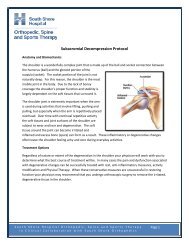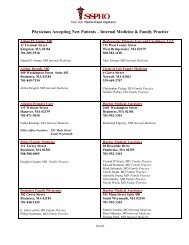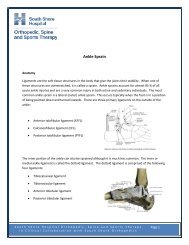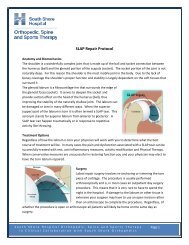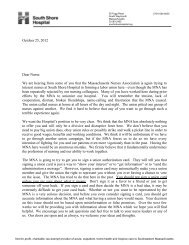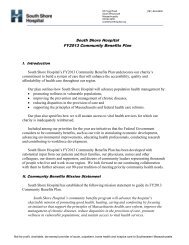2011 Nursing Annual Report - FINAL.pub - South Shore Hospital
2011 Nursing Annual Report - FINAL.pub - South Shore Hospital
2011 Nursing Annual Report - FINAL.pub - South Shore Hospital
Create successful ePaper yourself
Turn your PDF publications into a flip-book with our unique Google optimized e-Paper software.
Transformational LeadershipThe Art of Active Listening: Do You Hear What I Hear?Communicating with colleagues isone of the most important thingswe do as members of <strong>South</strong> <strong>Shore</strong><strong>Hospital</strong>. It doesn’t matterwhether that colleague is a frontlineclinician, physician, communitypartner, or a member of ourexecutive team – how we interactwith each other drives our abilityto execute our strategic plan andultimately meet the needs of thecommunity we serve. Communicationis made up of many interrelatedcomponents; one of themost important of these is activelistening. Once developed, the artof listening becomes the foundationfrom which we build programsand teams together.Over the last several years, ourleadership meetings and quarterlycolleague forums introduced theguiding principles of Patient andFamily Centered Care. These principlescan and should be applied tocolleagues as well. Each day wespend three fourths of the hoursthat we are awake reading, writing,speaking and listening, andout of that time, 40‐50% is (orshould be) spent listening. However,unlike reading, writing andspeaking, which have a wide arrayof formal and informal educationalprocesses during the course of ourlifetime, only two weeks of formaltraining is dedicated to the art oflistening.Truly listening to someone meanstranscending your own story – bygetting out of your frame of reference,value system, history andjudging tendencies – and embeddingyourself into the frame ofreference or viewpoint of anotherperson. Only when empatheticlistening occurs do we hear thingsfrom the perspective of the personwho is speaking.Active listening does not end withthe conversation. Once you hearthe voices of your colleagues, thenext step in the process is providingfeedback, which can come in avariety of ways and should occurdaily. When ideas, suggestions orfeedback are received, a responseis necessary. It does not matter ifthe idea, suggestion or feedbackwill be acted upon. The key is toprovide the response and explainwhy it was accepted or declined,and acknowledge that we valueinput from all colleagues.How Can We Do Better? Really listen to the voices ofour colleagues (be an activelistener) Provide feedback when suggestions,concerns or ideas areshared (whether ideas areaccepted or declined) Ask colleagues for their inputfirst, not last (inclusion in decisionmaking) Look for mutually beneficialsolutions to problems or issuesas they ariseWhen we actively listen to thevoices of all our colleagues, webecome transformational leadersand agents for change. As leaders,we need to challenge ourselves toprovide the structure for change tooccur.63




